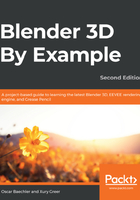
Making changes to components in Edit Mode
The Viking helmet provided in this scene is already halfway done, but as we can see in the following screenshot, it's missing some details: a nose guard, pyramid studs, and horns. To add these features, we need to switch to a different Interaction Mode:

Blender has several interaction modes that provide us with different ways of editing our models. We can see which mode we are in by looking at the header of the 3D Viewport; at the moment, it says Object Mode because we have been in Object Mode up to this point. While we are in Object Mode, we can move objects around, rotate them, and scale them, but we can't make any changes to the components of the objects.
To edit the components of the Viking Helmet object, we need to switch to Edit Mode. Edit Mode is where we can edit the components that make up a mesh object. As you may recall from Chapter 1, the components of a mesh are vertices, edges, and faces. Let's switch to Edit Mode:
- If it isn't already selected, select the Viking Helmet object.
- Go to the header of the 3D Viewport and click on Object Mode.
- Choose Edit Mode from the drop-down list:

Once we enter Edit Mode, we'll see that several things have changed regarding the User Interface: the 3D Viewport header has several new options, the interaction mode now says Edit Mode, the Toolbar on the left contains several new tools, and the Viking Helmet object has dots and lines drawn all over it, as shown in the following screenshot:

These dots and lines are the vertices and edges that the mesh is made out of. While we are in this mode, we aren't limited to selecting the object as a whole; we can select the individual components instead. Take a look at the header of the 3D Viewport again. Next to where it says Edit Mode, you'll see three component selection types: Vertex Select, Edge Select, and Face Select. These are represented by the icons shown here:

While we're in Edit Mode, we can switch between these selection modes by clicking on these three icons, or by pressing the 1, 2, and 3 hotkeys on the home row of the keyboard.
These selection modes provide us with flexibility in terms of the types of selections we can make, but they don't limit us to the types of operations we can perform on a mesh.
Most of the time, it doesn't matter which selection mode we use because when we have a face selected, all of its edges and vertices are also selected. It's even possible to activate all three selection modes at once by holding the Shift key before clicking on each icon. This can of course be overwhelming, so usually one at a time is enough.
We can also switch between the selection modes at any time. For example, we can make a selection in Face Select mode, then swap over to Vertex Select mode, and the selection will automatically be converted from a selection of faces into a selection of vertices (if possible).
There are a few edge cases (that's a pun) where we need to select edges but not faces, at which point Edge Select mode becomes very useful. But the rest of the time, we can use whichever selection mode works best for the task at hand.
We will switch between these three selection modes as needed while we're editing our models. Speaking of which, it's time to add a nose guard to the helmet!